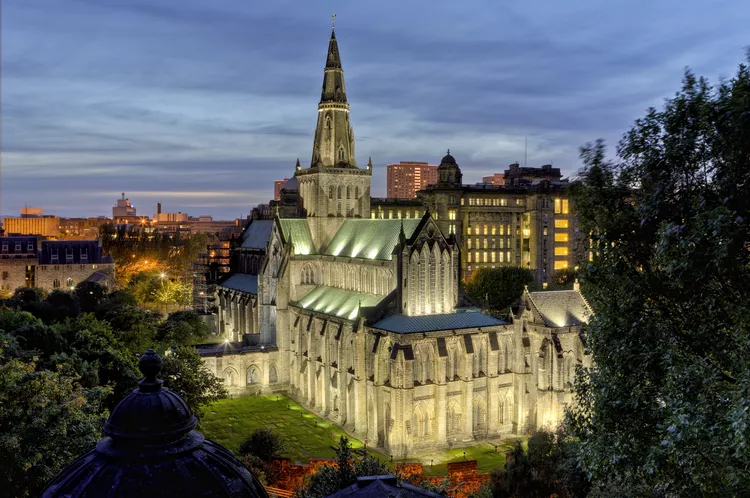Summary
1. Overview of Glasgow Cathedral
2. Historical Significance
3. St. Kentigern and St. Mungo
4. Preservation Through Change
5. Visiting Information
6. Highlights of the Cathedral
7. Nearby Attractions
Overview of Glasgow Cathedral
Glasgow Cathedral is the oldest cathedral in Scotland that has remarkably survived the Scottish Reformation of the 15th century intact. Officially known as St. Kentigern’s — commonly referred to as St. Mungo’s — it is owned by the Crown and maintained by a government agency known as Historic Environment Scotland. Understanding its historical significance offers insight into Scotland’s complex past.
A History of Glasgow Cathedral
The establishment of the Cathedral coincided with the founding of the city of Glasgow. St. Kentigern established a monastery beside the Molindinar Burn in the 5th century, which lent itself to the growth of a community. After his death in 603, he was laid to rest in what is believed to be a modest wooden church, the site of the current stone Cathedral built in the 11th and 12th centuries, consecrated in 1136 during the reign of King David of Scotland. The tomb located in the crypt is attributed to St. Kentigern.
St. Kentigern or St. Mungo
St. Kentigern was the offspring of a Scottish princess and Owain, King of Rheged, a region corresponding to present-day Northwestern England and the Scottish Borders. Various tales describe their origin, suggesting either love or coercion. When St. Kentigern’s mother became pregnant, her father punished her harshly. Miraculously, she survived and gave birth in Fife. Initially named Kentigern, he received the affectionately coined nickname Mungo, meaning little dear, from St. Serf, who cared for him. This affectionate moniker has led to the two names being used interchangeably.
How the Church Kept its Roof
The Scottish Reformation formed part of the broader Protestant Reformation sweeping through Europe, with Scotland maintaining its distinct sovereignty from England at that time. It continued to uphold Catholic traditions for around three decades following the break with Rome orchestrated by Henry VIII. While English Abbeys faced widespread destruction, the destruction of churches in Scotland was largely driven by grassroots movements, often led by anti-Catholic factions. The residents of Glasgow were evidently too enamored with their stunning Gothic Cathedral to endorse its demolition. An intriguing theory posits that, given Glasgow’s sizable population, opposition to the destructive mobs prevailed.
Despite losing its Roman connections, the Cathedral operated as a parish church hosting multiple congregations for a period. Nevertheless, in the mid-19th century, authorities recognized its historic and aesthetic value, designating it for one congregation of the Church of Scotland. Today, it is known formally as the High Kirk of Glasgow.
How to Visit Glasgow Cathedral
The Cathedral is accessible to visitors daily, except on December 25-26 and January 1-2. While worshippers can attend services on those days and regular Sunday worship, entrance remains free. Children under 16 are required to be accompanied by an adult. Hours of operation differ seasonally and also vary for the lower church, which houses the crypt, and the upper church. Ensure you check the Historic Scotland website for the most current opening information. Centrally located in Glasgow, it is approximately a 15-minute walk from George’s Square and Queen Street Station, the city’s primary rail station. Alternatively, you can use the 38 or 57 SimpliCITY Buses operated by First Greater Glasgow.
Highlights of a Visit
Positioned on a hill, the Cathedral features both upper and lower levels. Among the noteworthy attractions are:
- The captivating crypt of St. Kentigern, constructed in the 1200s to honor the founder of the church and Glasgow.
- A distinctive layout with three aisles in the nave, showcasing Blackadder’s aisle, famous for its intricately carved ceiling adorned with vividly painted bosses.
- A decorative stone screen, known as the pulpitum, separating the choir and the nave, added in the 14th century.
- One of the finest collections of post-WWII stained glass windows in Britain, with highlights including the Millennium Window by John Clark and the 1958 Creation Window by Francis Spear.
- Engage in a guided tour of the Cathedral. Volunteer guides are available to escort one to three individuals on a one-hour tour; while no fee is required, donations to the church are encouraged.
Things to Do Near Glasgow Cathedral
As the oldest building in the city, the Cathedral is surrounded by a wealth of historical sites. Nearby, visitors can explore:
- Provand’s Lordship: This historic building, completed in 1471, is one of Glasgow’s four surviving medieval structures. It showcases furnishings reflecting its 1600s heritage and is complemented by a tranquil herb garden void of any modern intrusions.
- St. Mungo Museum of Religious Life and Art: Set on the site of a former Medieval bishop’s palace, this museum resembles an ancient edifice while being a modern creation. Its galleries delve into the impact of religion on global cultures across various faiths. While the subject matter might seem dry, the museum is a treasure trove of intriguing artwork from both modern and historical realms, ensuring visitors find it engaging.
- The Glasgow Necropolis: Positioned on a notable hill adjacent to the Cathedral, the Necropolis offers panoramic views of the city. Originally intended as a garden park and arboretum, by the early 19th century, it evolved into a cemetery designed to echo the renowned Père Lachaise Cemetery. Visitors can admire its elaborate Victorian mausoleums and stone sculptures. Free walking tours are available, detailing its history, architecture, and notable residents. Covering an impressive 37 acres, visits typically require about two hours.





